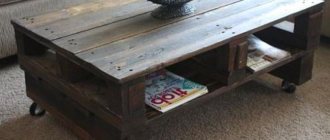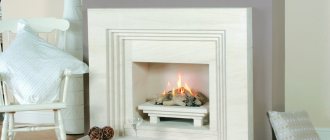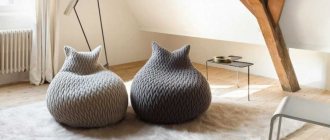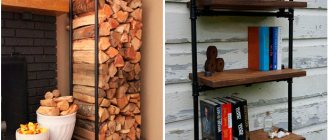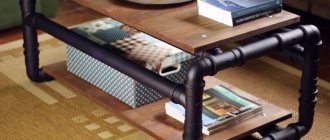If you have a heating and gas pipe in your kitchen or any other room that does not fit into the design of the space, then you can easily decorate it with improvised means. Today there are a large number of ways to disguise a heating pipe without disrupting the heating process. In order to decorate pipes, you will need to use creative thinking. During the decorating process, it is useful to familiarize yourself with the following recommendations:
- It is not recommended to permanently hide communications in a house or apartment. The fact is that threaded connections can fail and leak. In order to restore their functionality, it is necessary to have unhindered access to them.
- Risers and connections are directly involved in heating the space. If you use decorative boxes, the room may become a little colder.
- Decorative casings and boxes should be easily dismantled when used. It is better to use gratings that have large cells.
Bamboo pipe decor in the kitchen
Decorative pipes in the bathroom interior
Requirements and limitations for decorating pipelines
The gas pipeline is a high-risk utility line that is subject to special operating requirements. This must be taken into account when creating the decor of a gas pipe in the kitchen:
The entire length of the gas pipe must be accessible for inspection. That is, all camouflage and decorative structures must be quick-removable. It cannot be hidden in plaster, strobing, or under any other type of non-removable cladding;
Boxes and similar structures should not be tightly closed. If there is a leak at one of the joints, gas can accumulate in the internal space, which significantly increases the risk of explosion. Therefore, all enclosing structures of this type must have sufficient prostration to ensure good ventilation;
The location of pipelines cannot be changed without agreement with the relevant regulatory services;
Do not apply mechanical pressure or any other load. That is, hang various decorative elements on the gas pipe and use it as a supporting structure;
The surface of the gas pipe must be painted to prevent corrosion. As for the color that needs to be painted on the indoor pipeline, it is not regulated;
There is only one limitation for decorating heating pipes. It is necessary to select a finishing material that is resistant to temperature changes and that, when heated, does not emit strong-smelling and carcinogenic substances.
Several original ideas
There are a number of design techniques that can be used to decorate heating risers. Many people will probably find them useful when solving the problem of hiding pipes or giving them a more aesthetic appearance.
Coloring
Painting is the most expensive and most accessible option for many owners for decorating heating pipes. Below we provide several examples of ready-made solutions.
You can try to turn the element in question into parts of the interior, for example, a children's room.
If you refuse to use the traditional white color, which is habitually used by many owners to paint pipes, then the vertical structure may turn into wood. Wall painting can begin from here. To do this, just draw branches on them. Even a person who does not have drawing skills can cope with such work. And having created branches on a tree, you cannot do without leaves, which are also worth drawing. It is unlikely that anyone will have problems with this.
You can involve your child in creating leaves on such a tree , who will be happy to help you in this exciting task.
It is quite easy to interest him in this activity, especially if you change the leaves on this tree depending on the time of year. By decorating pipes according to the season, you will have the opportunity to create an interesting game for your child, in which he will learn accuracy and develop his powers of observation, as well as his love of nature. In the bedroom and living room, you can use a different approach to the design of heating pipes.
Here, when painting, it is best to choose a noble golden color, or you can use a more silver one. Bronze would also be quite appropriate here. The main point is that the chosen shade should be combined with the style of the room. When choosing the color of paint that will be used to paint the heating risers in the room, you need to focus mainly on the color scheme that is dominant in furniture and window fittings.
Decoration
When designing heating pipes, you don’t have to limit your imagination and use one of the ideas offered by designers:
- wrapping a pipe with rope is a rather original method of decorating it. But you need to close it not with an ordinary rope, but with a cord made of hemp or jute. If you are not worried that the heat transfer of the pipes from such a design will decrease, then you can consider this option;
- Another equally interesting option is the use of bamboo trunks. The halves attached to the pipe are then glued together. The result is an original body made of natural material , which perfectly decorates the vertical heating pipe. If you cover the pipe not with bamboo, but with artificial flowers, then such an unusual decoration will be noticed not only by your family, but also by the guests who come to you;
- If in some rooms of your apartment the pipes go to the floor, then they can be decorated using decorative overlays. You just need to choose the right color and texture, and the image will be complete;
- To decorate pipes in an apartment, you can use fabric drapery , similar to curtains. This solution will create a certain charm in your apartment.
Stained glass
Stained glass was previously a fairly fashionable way to decorate homes. These days it is making a comeback and becoming a favorite method among designers. You can also think about using it to decorate pipes. By creating a partition with stained glass elements in the corner of the room in which the heating pipes are located, it will be transformed and will look quite elegant. Having made a choice in favor of stained glass, you need to think about the lighting of the created composition. In this case, the stained glass window will not only decorate the room, but also act as a night light , creating an atmosphere of romance in the room.
Painting and painting
Painting is a budget-friendly way to decorate or disguise pipelines. There are several common techniques that can be successfully used in rooms decorated in any style:
Painting to match the walls. Applicable if the room has plain walls in calm pastel colors. By successfully selecting matching tones, you can achieve maximum camouflage. Suitable for Provence and Scandinavian styles.
Painted in a contrasting color. It is used if the room is decorated brightly, using rich colors.
It is necessary to choose a color for the pipes so that it harmonizes or completely matches the tone of one of the main elements of the room. For example, textiles, kitchen units or nearby walls. This decoration looks harmonious in avant-garde or kitsch styles;
Painting for “engineering communications”. Highlighting the pipe in its original form, as one of the main decorative elements of the room, is welcomed in loft, industrial or high-tech styles. In this case, the pipes can be painted black, bronze or chrome.
Decoupage or painting. This design is typical for rooms made in ethno style. In this case, either a floral or geometric ornament is applied along the entire length of the pipe in accordance with the general design of the room.
Disguise using railing
For horizontal pipes that run low, just at the level of the kitchen apron, there is an excellent method of camouflage - imitation of a roof rail. It should be remembered that nothing can be hung on the pipe itself, so the supporting rail itself is attached above the gas pipe, which is painted in color.
Decoration with textiles and pasting
Rope or coconut copra are used as textile decorative elements. It is often practiced to glue various pebbles, glass, etc.
To secure decorative elements to the heating pipe, it is necessary to use heat-resistant glue, which does not expand or crack when heated. Where to buy decor for pipes depends on its type. These could be handicraft stores, construction hypermarkets, etc.
IMPORTANT! The use of such decor for metal or plastic pipes leading to the stove may cause dissatisfaction with representatives of the gas service during the next check of the meter and become a reason for a fine.
Which decorative screen is better?
At the moment, decorative boxes for pipes of heating systems are made from the following materials:
- plastic;
- metal;
- MDF;
- wood.
Plastic is one of the worst materials for making boxes designed to hide hot pipes. The fact is that in order to reduce prices, manufacturers use inexpensive types of plastic for these products. Such material quickly warps from heating, loses its appearance, or even turns yellow and becomes brittle. Of all types of screens, a plastic pipe box is the cheapest, but it does not last long and is well suited as a temporary solution to the problem. The plastic box made to look like a plinth deserves attention, but this is a different price category.
Metal, on the contrary, is the best solution for decorative fencing of heating risers and mains. Products with frequent perforations or lattice designs are especially good. Metal is an excellent conductor of heat and will successfully transfer it into the room, and through the holes the casing will allow enough air inside for heating. So from the technical side, metal has no equal.
From the point of view of operation, steel products are also at their best. They are coated with a durable polyester powder coating that can withstand high temperatures and various mechanical stress. Again, metal boxes can always be repainted if necessary, so they will last a long time. Well, the last argument in favor of steel screens: they are easy to clean in any way, even wipe with a rag, or remove and wash in the bathroom under running water.
Use of kitchen furniture
Marking the pipeline and gas meter behind furniture facades requires much larger capital investments.
It is necessary to develop the design of the kitchen unit in such a way that vertical pencil cases and hanging cabinets are located in the appropriate places and heights. At the same time, the interior space of the cabinet can be used for storing utensils.
Using bamboo
Bamboo has always provided designers with ample opportunities for decorating rooms. Pipelines were no exception. There are several ways to cover pipes with bamboo decor. As a rule, it is used to mask a vertically located pipeline:
The placement of the pipe inside a thick bamboo trunk.
If the pipe is located far enough from the wall, then the bamboo is carefully sawed lengthwise, but not in half, and choosing a quarter according to the diameter of the pipe. So that the cut seams can be turned towards the wall. All partitions inside are removed. The sawn parts can be secured with glue or tied in several places with decorative twine.
The second option is preferable; the structure becomes collapsible and can be quickly dismantled to provide free access when inspecting the pipe. If the pipeline is installed close to the wall, then the bamboo trunk can be cut in half and attached directly to the wall.
The vertical pipeline can be blocked with a small diameter using several thin bamboo stalks. The stems are installed at a slight angle next to the main pipe, which is painted to imitate bamboo.
With ropes
The original decor of vertical and horizontal communications can be done with ropes. It is not recommended to use the cheapest jute ropes (with an uneven surface) for work, since they quickly become covered with dust and it is difficult to remove. But neat, smooth analogues made of jute (regular or dyed) are suitable for use in living rooms and toilets. Vertical layout using this material can be stylized as wood or palm tree. For such decoration, it is recommended to fix artificial greenery, branches with plastic lemons or oranges in the upper part of the braided communications.
In a small Khrushchev-era building, using thin ropes, you can create original marine decorations. White cotton ropes are suitable for the job. In this case, the horizontal wiring can not only be braided, but also decorated with flowing ropes. Additionally, small shells can be glued to the braid.
GCR boxes for pipes
Plasterboard boxes for masking pipelines do not differ in composition from standard gypsum board designs. For this, standard profiles are used. However, given the small load on the structure, you can limit yourself to using profiles CD 26/27 as load-bearing ones and UD27/28 to create jumpers.
The gypsum boards are fastened to the frame using self-tapping screws with a reinforced anti-corrosion coating. After creating the box, it must be puttied and painted.
False wall
In a situation where the pipework is large and creating a small box will not solve the problem, you should make a full-fledged false wall. It is assembled from profiles and plasterboard sheets. It is recommended to supplement the created ledge with a plumbing hatch. This will allow owners to easily access communications and repair or replace them. In plumbing rooms, the false wall may be non-standard. To do this, boxes are assembled on the left and right, and plumbing roller shutters are hung on top of them. This solution will allow you to instantly gain access to the wiring, eliminate the leak and carry out a complete replacement of communications without delay. The false wall itself can be covered with wallpaper or painted or tiled. Moisture-resistant plasterboard sheets should be used as a base.

